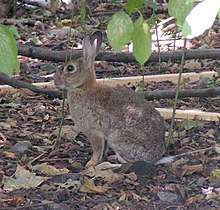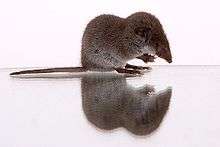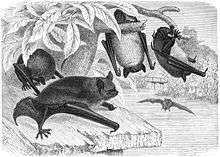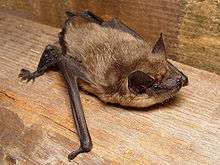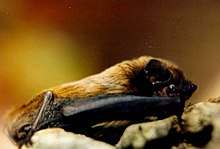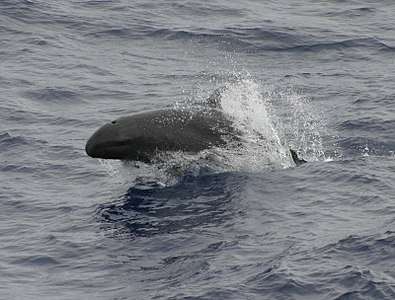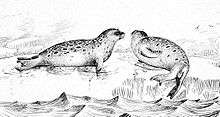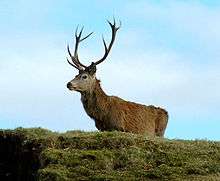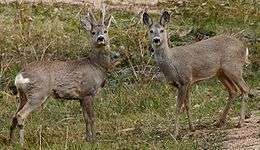List of mammals of Portugal
This list shows the IUCN Red List status of the 93 mammal species occurring in Portugal. One of them is critically endangered, three are endangered, eleven are vulnerable, and one is near threatened. The following tags are used to highlight each species' status as assessed on the respective IUCN Red List published by the International Union for Conservation of Nature:
| EX | Extinct | No reasonable doubt that the last individual has died. |
| EW | Extinct in the wild | Known only to survive in captivity or as a naturalized populations well outside its previous range. |
| CR | Critically endangered | The species is in imminent risk of extinction in the wild. |
| EN | Endangered | The species is facing an extremely high risk of extinction in the wild. |
| VU | Vulnerable | The species is facing a high risk of extinction in the wild. |
| NT | Near threatened | The species does not meet any of the criteria that would categorise it as risking extinction but it is likely to do so in the future. |
| LC | Least concern | There are no current identifiable risks to the species. |
| DD | Data deficient | There is inadequate information to make an assessment of the risks to this species. |
Subclass: Theria
Infraclass: Eutheria
Order: Rodentia (rodents)

Rodents make up the largest order of mammals, with over 40% of mammalian species. They have two incisors in the upper and lower jaw which grow continually and must be kept short by gnawing.
- Suborder: Castorimorpha
- Family: Castoridae (beavers)
- Genus: Castor
- Eurasian beaver, C. fiber LC[1]
- Genus: Castor
- Family: Castoridae (beavers)
- Suborder: Sciurognathi
- Family: Sciuridae (squirrels)
- Subfamily: Sciurinae
- Genus: Sciurus
- Red squirrel, S. vulgaris LC[2]
- Genus: Sciurus
- Subfamily: Sciurinae
- Family: Gliridae (dormice)
- Subfamily: Leithiinae
- Genus: Eliomys
- Garden dormouse, E. quercinus NT[3]
- Genus: Eliomys
- Subfamily: Leithiinae
- Family: Cricetidae (hamsters, voles, lemmings)
- Subfamily: Arvicolinae
- Genus: Arvicola
- Southwestern water vole, A. sapidus VU[4]
- European water vole, A. amphibius LC[5]
- Genus: Microtus
- Cabrera's vole, M. cabrerae NT[6]
- Field vole, M. agrestis LC
- Mediterranean pine vole, M. duodecimcostatus LC
- Lusitanian pine vole, M. lusitanicus LC
- Genus: Arvicola
- Subfamily: Arvicolinae
- Family: Muridae (mice and rats)
- Subfamily: Murinae
- Genus: Apodemus
- Wood mouse, A. sylvaticus LC
- Genus: Mus
- House mouse, M. musculus LC
- Algerian mouse, M. spretus LC
- Genus: Rattus
- Genus: Apodemus
- Subfamily: Murinae
- Family: Sciuridae (squirrels)
Order: Lagomorpha (lagomorphs)
The lagomorphs comprise two families, Leporidae (hares and rabbits), and Ochotonidae (pikas). Though they can resemble rodents, and were classified as a superfamily in that order until the early 20th century, they have since been considered a separate order. They differ from rodents in a number of physical characteristics, such as having four incisors in the upper jaw rather than two.
- Family: Leporidae (rabbits, hares)
- Genus: Oryctolagus
- European rabbit, O. cuniculus EN[8]
- Genus: Lepus
- Granada hare, L. granatensis LC[9]
- Genus: Oryctolagus
Order: Erinaceomorpha (hedgehogs and gymnures)

The order Erinaceomorpha contains a single family, Erinaceidae, which comprise the hedgehogs and gymnures. The hedgehogs are easily recognised by their spines while gymnures look more like large rats.
- Family: Erinaceidae (hedgehogs)
- Subfamily: Erinaceinae
Order: Soricomorpha (shrews, moles, and solenodons)
The "shrew-forms" are insectivorous mammals. The shrews and solenodons closely resemble mice while the moles are stout-bodied burrowers.
- Family: Soricidae (shrews)
- Subfamily: Crocidurinae
- Genus: Crocidura
- Lesser white-toothed shrew, C. suaveolens LC[11]
- Greater white-toothed shrew, C. russula LC
- Genus: Suncus
- Etruscan shrew, S. etruscus LC
- Genus: Crocidura
- Subfamily: Soricinae
- Tribe: Nectogalini
- Genus: Neomys
- Southern water shrew, N. anomalus LC
- Genus: Neomys
- Tribe: Soricini
- Genus: Sorex
- Iberian shrew, S. granarius LC
- Eurasian pygmy shrew, S. minutus LC
- Genus: Sorex
- Tribe: Nectogalini
- Subfamily: Crocidurinae
- Family: Talpidae (moles)
Order: Chiroptera (bats)
The bats' most distinguishing feature is that their forelimbs are developed as wings, making them the only mammals capable of flight. Bat species account for about 20% of all mammals.
- Family: Vespertilionidae
- Subfamily: Myotinae
- Genus: Myotis
- Bechstein's bat, M. bechsteini NT[13]
- Greater mouse-eared bat, M. myotis LC[14]
- Daubenton's bat, M. daubentonii LC
- Geoffroy's bat, M. emarginatus LC
- Escalera's bat, M. escalerai LC
- Whiskered bat, M. mystacinus LC
- Natterer's bat, M. nattereri LC
- Genus: Myotis
- Subfamily: Vespertilioninae
- Genus: Barbastella
- Barbastelle, B. barbastellus NT
- Genus: Eptesicus
- Serotine bat, E. serotinus LC
- Genus: Nyctalus
- Greater noctule bat, N. lasiopterus NT[15]
- Lesser noctule, N. leisleri LC[16]
- Common noctule, N. noctula LC[17]
- Azores noctule, N. azoreum VU
- Genus: Pipistrellus
- Madeira pipistrelle, P. maderensis VU
- Genus: Plecotus
- Brown long-eared bat, P. auritus LC
- Grey long-eared bat, P. austriacus LC
- Genus: Barbastella
- Subfamily: Myotinae
- Family: Miniopteridae
- Genus: Miniopterus
- Schreibers' long-fingered bat, M. schreibersii LC
- Genus: Miniopterus
- Family: Molossidae
- Genus: Tadarida
- European free-tailed bat, T. teniotis LC
- Genus: Tadarida
- Family: Rhinolophidae
- Subfamily: Rhinolophinae
- Genus: Rhinolophus
- Mehely's horseshoe bat, R. mehelyi VU
- Mediterranean horseshoe bat, R. euryale NT
- Greater horseshoe bat, R. ferrumequinum LC
- Lesser horseshoe bat, R. hipposideros LC
- Genus: Rhinolophus
- Subfamily: Rhinolophinae
Order: Cetacea (whales)
The order Cetacea includes whales, dolphins and porpoises. They are the mammals most fully adapted to aquatic life with a spindle-shaped nearly hairless body, protected by a thick layer of blubber, and forelimbs and tail modified to provide propulsion underwater.
- Suborder: Mysticeti
- Family: Balaenidae
- Genus: Eubalaena
- North Atlantic right whale, E. glacialis EN
- Genus: Eubalaena
- Family: Balaenopteridae
- Subfamily: Balaenopterinae
- Genus: Balaenoptera
- Fin whale, B. physalus EN
- Genus: Balaenoptera
- Subfamily: Balaenopterinae
- Family: Balaenidae
- Suborder: Odontoceti
- Superfamily: Platanistoidea
- Family: Phocoenidae
- Genus: Phocoena
- Harbour porpoise, P. phocoena VU
- Genus: Phocoena
- Family: Physeteridae
- Genus: Physeter
- Sperm whale, P. macrocephalus VU
- Genus: Physeter
- Family: Kogiidae
- Genus: Kogia
- Pygmy sperm whale, K. breviceps DD[18]
- Dwarf sperm whale, K. sima LC
- Genus: Kogia
- Family: Ziphidae
- Genus: Ziphius
- Cuvier's beaked whale, Z. cavirostris DD
- Subfamily: Hyperoodontinae
- Genus: Hyperoodon
- Bottlenose whale, H. ampullatus DD
- Genus: Mesoplodon
- Sowerby's beaked whale, M. bidens DD
- Blainville's beaked whale, M. densirostris DD
- True's beaked whale, M. mirus DD
- Genus: Hyperoodon
- Genus: Ziphius
- Family: Delphinidae (marine dolphins)
- Genus: Steno
- Rough-toothed dolphin, S. bredanensis DD
- Genus: Tursiops
- Bottlenose dolphin, T. truncatus DD
- Genus: Stenella
- Striped dolphin, S. coeruleoalba DD
- Atlantic spotted dolphin, S. frontalis DD
- Genus: Delphinus
- Short-beaked common dolphin, D. delphis VU
- Genus: Lagenorhynchus
- Atlantic white-sided dolphin, L. acutus LC
- White-beaked dolphin, L. albirostris LC
- Genus: Grampus
- Risso's dolphin, G. griseus DD
- Genus: Feresa
- Pygmy killer whale, F. attenuata DD
- Genus: Pseudorca
- False killer whale, P. crassidens LC
- Genus: Globicephala
- Short-finned pilot whale, G. macrorhynchus LC
- Long-finned pilot whale, G. melas LC
- Genus: Steno
- Family: Phocoenidae
- Superfamily: Platanistoidea
Order: Carnivora (carnivorans)
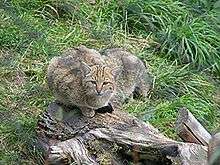
There are over 260 species of carnivorans, the majority of which primarily eat meat. They have a characteristic skull shape and dentition.
- Suborder: Feliformia
- Family: Felidae (cats)
- Subfamily: Felinae
- Genus: Felis
- European wildcat, F. silvestris LC
- Genus: Lynx
- Iberian lynx, Lynx pardinus EN[19]
- Genus: Felis
- Subfamily: Felinae
- Family: Viverridae (civets, mongooses, etc.)
- Subfamily: Viverrinae
- Genus: Genetta
- Common genet, G. genetta LC[20] introduced
- Genus: Genetta
- Subfamily: Viverrinae
- Family: Herpestidae (mongooses)
- Genus: Herpestes
- Egyptian mongoose, H. ichneumon LC[21]
- Genus: Herpestes
- Family: Felidae (cats)
- Suborder: Caniformia
- Family: Canidae (dogs, foxes)
- Family: Ursidae (bears)
- Genus: Ursus
- Brown bear, U. arctos LC[24]
- Eurasian brown bear, U. a. arctos locally EX
- Brown bear, U. arctos LC[24]
- Genus: Ursus
- Family: Mustelidae (mustelids)
- Genus: Mustela
- Stoat, M. erminea LC[25]
- Least weasel, M. nivalis LC[26]
- European polecat, M. putorius LC[27]
- Genus: Martes
- Beech marten, M. foina LC[28]
- European pine marten, M. martes LC[29]
- Genus: Meles
- Eurasian badger, M. meles LC[30]
- Genus: Lutra
- European otter, L. lutra NT[31]
- Genus: Mustela
- Family: Phocidae (earless seals)
- Genus: Cystophora
- Hooded seal, Cystophora cristata LC
- Genus: Erignathus
- Bearded seal, Erignathus barbatus LC
- Genus: Monachus
- Mediterranean monk seal, M. monachus EN[32]
- Genus: Phoca
- Common seal, P. vitulina LC
- Genus: Pusa
- Ringed seal, P. hispida LC
- Genus: Cystophora
Order: Artiodactyla (even-toed ungulates)
The even-toed ungulates are ungulates whose weight is borne about equally by the third and fourth toes, rather than mostly or entirely by the third as in perissodactyls. There are about 220 artiodactyl species, including many that are of great economic importance to humans.
- Family: Cervidae
- Subfamily: Cervinae
- Genus: Cervus
- Red deer, C. elaphus LC
- Genus: Dama
- Fallow deer, D. dama LC[33]
- Genus: Cervus
- Subfamily: Capreolinae
- Subfamily: Cervinae
- Family: Bovidae
- Family: Suidae
See also
References
- Batbold, J.; Batsaikhan, N.; Shar, S.; Hutterer, R.; Kryštufek, B.; Yigit, N.; Mitsain, G. & Palomo, L. (2016). "Castor fiber". IUCN Red List of Threatened Species. 2016: e.T4007A115067136.
- Amori, G.; Hutterer, R.; Kryštufek, B.; Yigit, N.; Mitsain, G. & Muñoz, L. J. P. (2010). "Sciurus vulgaris". IUCN Red List of Threatened Species. 2010: e.T20025A9136220.
- Bertolino, S.; Amori, G.; Henttonen, H.; Zagorodnyuk, I.; Zima, J.; Juškaitis, R.; Meinig, H. & Kryštufek, B. (2008). "Eliomys quercinus". IUCN Red List of Threatened Species. 2008: e.T7618A12835766.
- Rigaux, P.; Vaslin, M.; Noblet, J. F.; Amori, G. & Muñoz, L. J. P. (2008). "Arvicola sapidus". IUCN Red List of Threatened Species. 2008: e.T2150A9290712.
- Batsaikhan, N.; Henttonen, H.; Meinig, H.; Shenbrot, G., Bukhnikashvili, A., Hutterer, R., Kryštufek, B., Yigit, N., Mitsain, G. & Palomo, L. (2016). "Arvicola amphibius". IUCN Red List of Threatened Species. 2016: e.T2149A115060819.CS1 maint: multiple names: authors list (link)
- Fernandes, M.; Pita, R. & Mira, A. (2019). "Microtus cabrerae". IUCN Red List of Threatened Species. 2019: e.T13418A90931498.
- Kryštufek, B.; Palomo, L.J.; Hutterer, R.; Mitsain, G. & Yigit, N. (2015). "Rattus rattus". IUCN Red List of Threatened Species. 2015: e.T19360A115148682.
- Villafuerte, R.; Delibes-Mateos, M. (2019). "Oryctolagus cuniculus". IUCN Red List of Threatened Species. 2019: e.T41291A45189779.
- Soriguer, R. & Carro, F. (2019). "Lepus granatensis". IUCN Red List of Threatened Species. 2019: e.T41306A2953195. doi:10.2305/IUCN.UK.2019-1.RLTS.T41306A2953195.en.CS1 maint: multiple names: authors list (link)
- Amori, G. (2016). "Erinaceus europaeus". IUCN Red List of Threatened Species. 2016: e.T29650A2791303. doi:10.2305/IUCN.UK.2016-3.RLTS.T29650A2791303.en.
- Hutterer, R.; Amori, G.; Krystufek, B.; Yigit, N.; Mitsain, G.& Palomo, L.J. (2010). "Crocidura suaveolens". IUCN Red List of Threatened Species. 2010: e.T29656A9511068.CS1 maint: multiple names: authors list (link)
- Fernandes, M.; Herrero, J.; Aulagnier, S. & Amori, G. (2008). "Galemys pyrenaicus". IUCN Red List of Threatened Species. 2008: e.T8826A12934876.
- Paunović, M. (2019). "Myotis bechsteinii". IUCN Red List of Threatened Species. 2019: e.T14123A22053752. doi:10.2305/IUCN.UK.2016-2.RLTS.T14123A22053752.en.
- Coroiu, I.; Juste, J. & Paunović, M. (2016). "Myotis myotis". IUCN Red List of Threatened Species. 2016: e.T14133A22051759. doi:10.2305/IUCN.UK.2016-2.RLTS.T14133A22051759.en.CS1 maint: multiple names: authors list (link)
- Hutson, A. M.; Alcaldé, J. T.; Juste, J.; Karataş, A.; Palmeirim, J. & Paunović, M. (2010). "Nyctalus lasiopterus". IUCN Red List of Threatened Species. 2010: e.T14918A4471682.CS1 maint: multiple names: authors list (link)
- Juste, J. & Paunović, M. (2016). "Nyctalus leisleri". IUCN Red List of Threatened Species. 2016: e.T14919A22016159. doi:10.2305/IUCN.UK.2016-2.RLTS.T14919A22016159.en.CS1 maint: multiple names: authors list (link){{cite iucn}}: error: malformed |page= identifier (help)
- Csorba, G. & Hutson, A.M. (2016). "Nyctalus noctula". IUCN Red List of Threatened Species. 2016: e.T14920A22015682. doi:10.2305/IUCN.UK.2016-2.RLTS.T14920A22015682.en.CS1 maint: multiple names: authors list (link)
- Taylor, B.L.; Baird, R.; Barlow, J.; Dawson, S.M.; Ford, J.K.B.; Mead, J.G.; Notarbartolo di Sciara, G.; Wade, P. & Pitman, R.L. (2012). "Kogia breviceps". IUCN Red List of Threatened Species. 2012: e.T11047A17692192. doi:10.2305/IUCN.UK.2012.RLTS.T11047A17692192.en.CS1 maint: multiple names: authors list (link)
- Rodríguez, A. & Calzada, J. (2015). "Lynx pardinus". IUCN Red List of Threatened Species. 2015: e.T12520A50655794.
- Gaubert, P.; Carvalho, F.; Camps, D. & Do Linh San, E. (2015). "Genetta genetta". IUCN Red List of Threatened Species. 2015: e.T41698A45218636.
- Do Linh San, E.; Maddock, A.H. & Gaubert, P. & Palomares, F. (2016). "Herpestes ichneumon". IUCN Red List of Threatened Species. 2016: e.T41613A45207211.CS1 maint: multiple names: authors list (link)
- Hoffmann, M. & Sillero-Zubiri, C. (2016). "Vulpes vulpes". IUCN Red List of Threatened Species. 2016: e.T23062A46190249.
- Boitani, L.; Phillips, M. & Jhala, Y. (2018). "Canis lupus". IUCN Red List of Threatened Species. 2018: e.T3746A119623865.
- McLellan, B. N.; Proctor, M. F.; Huber, D. & Michel, S. (2017). "Ursus arctos". IUCN Red List of Threatened Species. 2017: e.T41688A121229971.
- Reid, F.; Helgen, K. & Kranz, A. (2016). "Mustela erminea". IUCN Red List of Threatened Species. 2016: e.T29674A45203335.
- McDonald, R. A.; Abramov, A. V.; Stubbe, M.; Herrero, J.; Maran, T.; Tikhonov, A.; Cavallini, P.; Kranz, A.; Giannatos, G.; Kryštufek, B. & Reid, F. (2019). "Mustela nivalis". IUCN Red List of Threatened Species. 2019: e.T70207409A147993366.
- Skumatov, D.; Abramov, A.V.; Herrero, J.; Kitchener, A.; Maran, T.; Kranz, A.; Sándor, A.; Stubbe, M.; Saveljev, A.; Savour-Soubelet, A.; Guinot-Ghestem, M.; Zuberogoitia, I.; Birks, J.D.S.; Weber, A.; Melisch, R. & Ruette, S. (2016). "Mustela putorius". IUCN Red List of Threatened Species. 2016: e.T41658A45214384.CS1 maint: multiple names: authors list (link)
- Abramov, A.V.; Kranz, A.; Herrero, J.; Krantz, A.; Choudhury, A. & Maran, T. (2016). "Martes foina". IUCN Red List of Threatened Species. 2016: e.T29672A45202514.
- Herrero, J.; Kranz, A.; Skumatov, D.; Abramov, A.V.; Maran, T. & Monakhov, V.G. (2016). "Martes martes". IUCN Red List of Threatened Species. 2016: e.T12848A45199169.
- Kranz, A.; Abramov, A. V.; Herrero, J. & Maran, T. (2016). "Meles meles". IUCN Red List of Threatened Species. 2016: e.T29673A45203002.
- Roos, A.; Loy, A.; de Silva, P.; Hajkova, P. & Zemanová, B. (2015). "Lutra lutra". IUCN Red List of Threatened Species. 2015: e.T12419A21935287.
- Karamanlidis, A. & Dendrinos, P. (2015). "Monachus monachus": e.T13653A45227543. Cite journal requires
|journal=(help) - Masseti, M.; Mertzanidou, D. (2008). "Dama dama". IUCN Red List of Threatened Species. 2008: e.T42188A10656554. doi:10.2305/IUCN.UK.2008.RLTS.T42188A10656554.en.
External links
- "Animal Diversity Web". University of Michigan Museum of Zoology. 1995–2006. Retrieved 22 May 2007.

.jpg)

